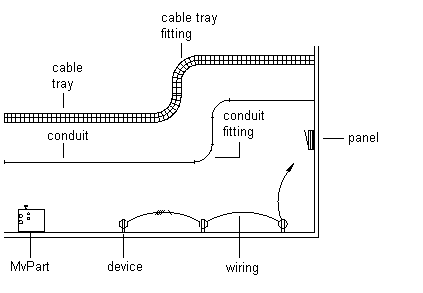Building systems are typically assembled from fabricated, off-the-shelf components. Catalog-based content refers to objects defined by part definitions and associated part models, and that are grouped into part catalogs. The part catalogs included with AutoCAD MEP 2024 toolset offer an extensive collection of parts for use during design. You can query the part catalogs to assist with part selection, retrieve parts for integration into your designs, and store parts you create in a catalog for future use.
You specify systems for catalog-based content. A system stores properties that are shared by all building system objects assigned to the system. This gives a consistent look and feel to the building systems in a drawing.

Parts of a mechanical system

Parts of an electrical system

Parts of a plumbing system
The following part catalogs are available in both metric and imperial units:
- Cable Tray
- Conduit
- Fittings
- Duct
- Pipe
- MvParts for all building systems disciplines
As you design systems, the parts and style-based content available to you depends on the catalogs and content locations you have specified on the MEP Catalogs tab of the Options dialog box. If you require a part that is not available, you can create catalog parts using Content Builder, a content creation tool that includes 3D modeling and 2D drawing features. You can create 2 types of parts: parametric or block-based.